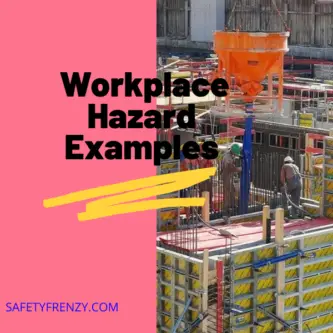Physical hazards are a common concern in various work settings, and identifying these hazards can help prevent workplace injuries and fatalities.
Below are some examples of physical hazards you should be aware of:
Noise Hazards
Noise hazards are common in industries such as manufacturing, construction, and aviation. Exposure to loud noise can cause hearing loss, tinnitus, and other hearing-related problems. Some examples of noise hazards in the workplace include:
- Construction equipment like jackhammers, drills, and saws
- Manufacturing machinery like conveyor belts, grinders, and stamping presses
- Aircraft engines and propellers
Employers should provide their workers with hearing protection devices and implement engineering controls to reduce noise levels.
Temperature Hazards
Temperature hazards are a concern in industries like construction, agriculture, and food service.
Extreme temperatures can cause heatstroke, hypothermia, and other health problems. Examples of temperature hazards in the workplace include:
- Working outdoors in extreme heat or cold
- Exposure to hot surfaces or flames in kitchens or manufacturing facilities
- Working in cold storage facilities
Employers should provide their workers with proper protective clothing and equipment, establish work/rest schedules, and monitor workers for signs of heat stress or hypothermia.
Ergonomic Hazards
Ergonomic hazards are common in industries that require repetitive motions, heavy lifting, or awkward postures.
These hazards can cause musculoskeletal disorders (MSDs) such as back pain, carpal tunnel syndrome, and tendonitis.
Examples of ergonomic hazards in the workplace include:
- Heavy lifting without proper equipment or training
- Poorly designed workstations or tools that cause awkward postures
- Repetitive motions like typing, using a mouse, or performing assembly line work
Employers should provide their workers with ergonomic training, implement engineering controls like adjustable workstations and tools, and encourage workers to take frequent breaks.
Chemical Hazards
Chemical hazards are a concern in industries like manufacturing, construction, and agriculture. Exposure to hazardous chemicals can cause acute and chronic health problems such as skin irritation, respiratory issues, and cancer. Examples of chemical hazards in the workplace include:
- Exposure to toxic gases like carbon monoxide or hydrogen sulfide
- Contact with corrosive substances like acids or alkalis
- Handling of hazardous materials like asbestos or lead
Employers should implement engineering controls like ventilation systems and proper storage procedures, provide their workers with appropriate personal protective equipment, and train their workers on proper handling and disposal of hazardous materials.
Biological Hazards
Biological hazards are a concern in industries like healthcare, hospitality, and agriculture. Exposure to biological hazards can cause illnesses such as hepatitis, HIV/AIDS, and tuberculosis. Examples of biological hazards in the workplace include:
- Exposure to blood or other bodily fluids
- Handling of infectious materials like mold or bacteria
- Contact with animals or animal products like feces or urine
Employers should implement proper infection control measures like hand hygiene, use of personal protective equipment, and proper disposal of contaminated materials.
Conclusion:
Identifying physical hazards in the workplace is crucial for preventing workplace injuries and fatalities.
By being aware of common physical hazards and taking appropriate measures to control them, employers can create a safe work environment for their workers.


